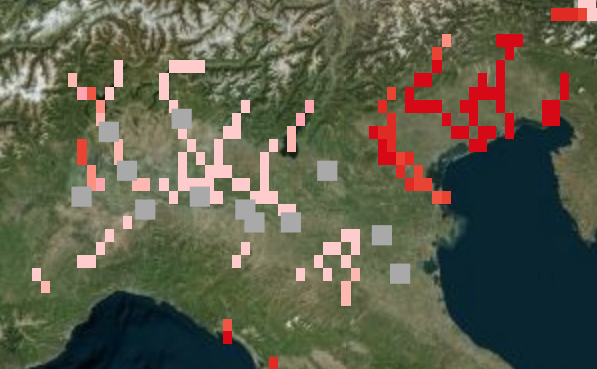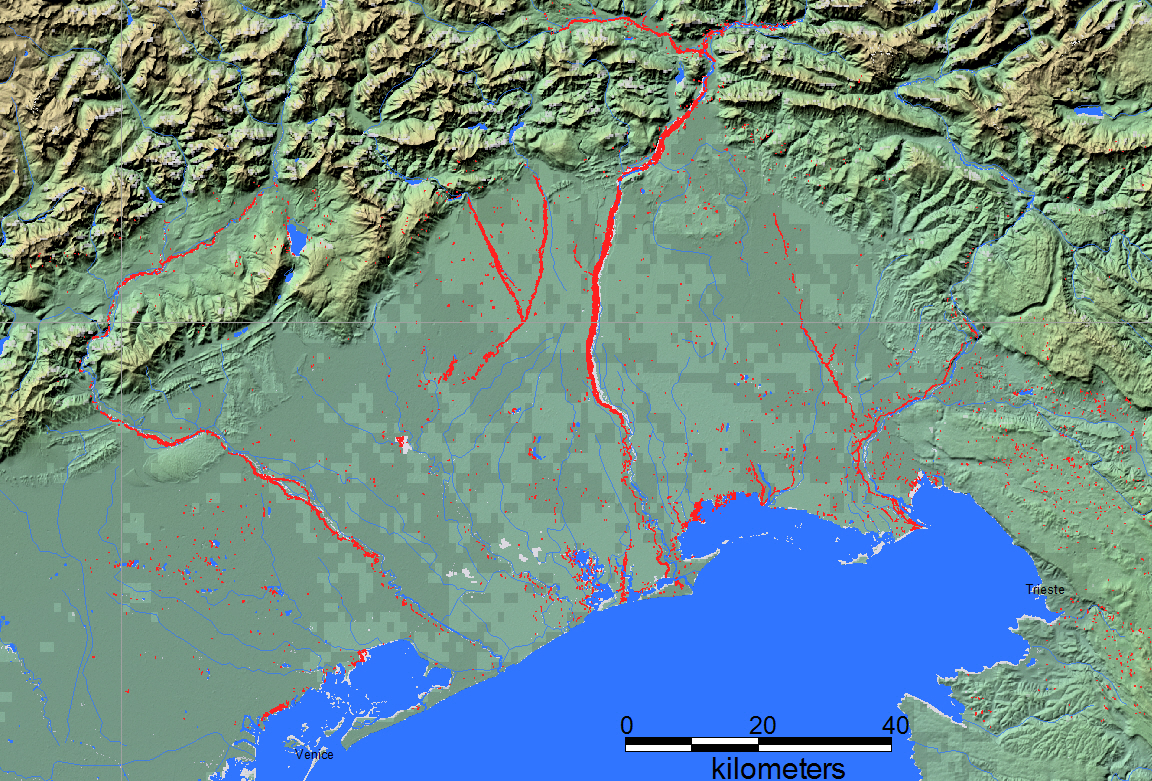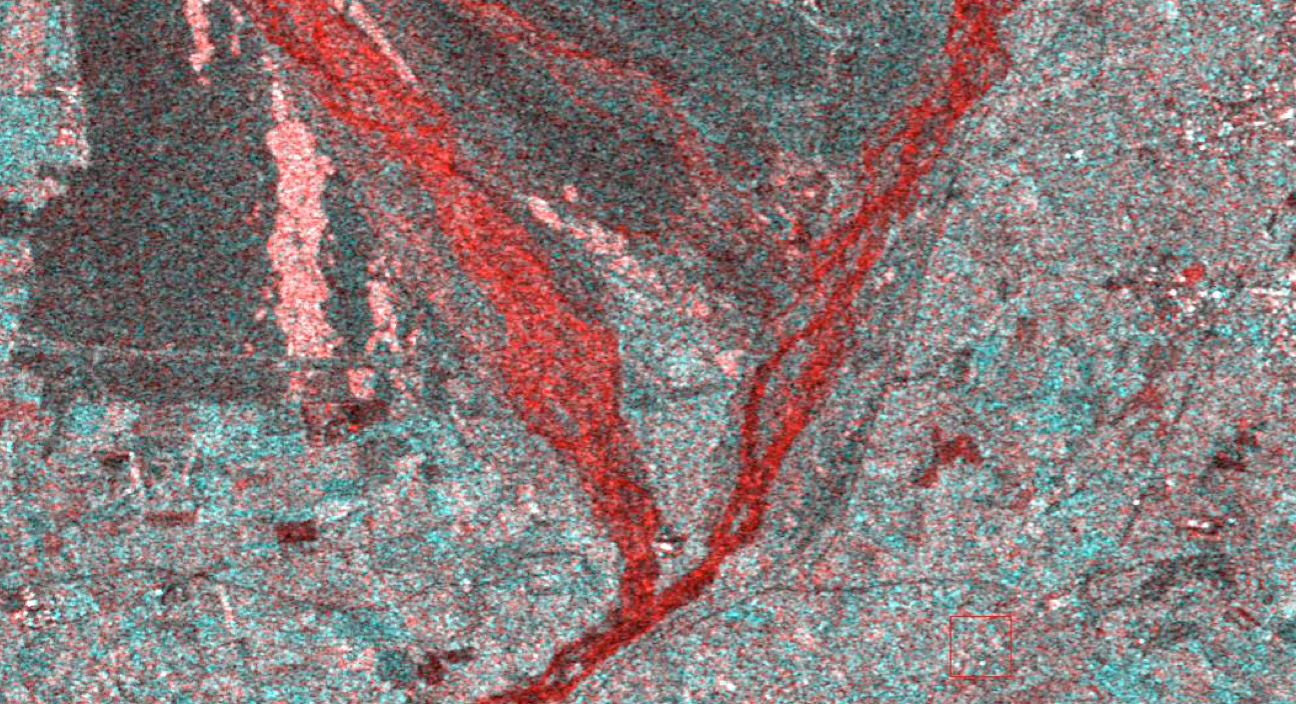







1. Predictive output of the NASA-supported Global Flood Monitoring System (GFMS) at ESSIC, University of Maryland. Date and UTC time is shown. Output obtained October 27, 2018.

3. Glofas Predicted Flooding. Output from October 26, 2018 applies to a 15 day forecast period.



These images are composed of single band "before" (VH polarization) Sentinel 1 SAR data and "during" or immediately "after" SAR data. These are 24 bit RGB geotifs, with "before" data on the B and G channels. Land areas that changed to smoother radar reflectivity will be in various shades of red; those that are rougher will appear as blue. Data are provided at their full (~ 10 m) spatial resolution in latitude and longitude projection. These images have no interpretation attached, but are provided immediately here after creation: for end users with processing systems and expertise sufficient to perform their own interpretation of changed areas. As DFO examines there results, example subscenes will also be provided below to highlight areas of interest. File names refer to the two dates; letters are adjacent scenes in the same orbit. After download, the paired .tfw files should be located in the same directory as the .tif files for easy reading into GIS software. Source data are Copernicus/ESA Sentinel SAR data from tthe Sentinels Science Data hub.
Sample Subscene

2018110120181020aS1.tif and associated tfw file.
2018110120181020bS1.tif and associated tfw file.
The Flood Observatory maintains a Global Active Archive of large flood events, 1985 to present. New major flood events are entered into this archive each week. A hand-drawn GIS polygon for each event outlines the region affected.
"Italy – Storms and Flooding Cause 11 Deaths 31 OCTOBER, 2018 BY FLOODLIST NEWS IN EUROPE, NEWS At least 11 people have died in Italy after storms and severe weather swept across parts of southern Europe, bringing strong winds, rough seas and heavy rain. Croatia, Slovenia, Bosnia, France and Switzerland have all been badly affected. Italy Six regions of Italy – Lombardy, Veneto, Friuli-Venezia Giulia, Liguria, Trentino-Alto Adige and Abruzzo – were put on red alert due to storms, torrential rain and strong winds from 29 October. Heavy rain has increased river levels and risk of landslides since then, with further severe weather expected. On 30 October Civil Protection issue red alerts for hydrogeological risk in Veneto and Trentino-Alto Adige regions, and an orange alert for Liguria." See more from FloodList
This event was selected for Observatory production of map and GIS data products.This web page and associated image and map (GIS) files become the permanent Flood Observatory record of the event after all data are collected and integrated. The objective is mapping of the maximum extent flooded and in relation to previous events.
As part of collaborations with other organizations, including
GEO and the Global Flood
Partnership, the Observatory's maps are made available here to the public.
Geotif versions and GIS files are also available. With attribution, maps and
data can be used freely for non-commercial purposes. With permission, they can
be used for commercial purposes. Consult the Creative Commons Attribution-NonCommercial-ShareAlike 4.0
International License and Robert.Brakenridge or Albert.Kettner (at
Colorado.edu) if questions. Attribution for this map when Sentinel SAR data are
used: "Dartmouth Flood Observatory at the University of Colorado, from satellite
data provided by NASA and Copernicus/European Space Agency." When using GIS data
(see below) provided to DFO from other sources, please acknowledge original
source (identifiable from the source directory). For example, this display uses
shp files produced at DFO from geotif water/land classified products from: Xinyi
Shen, Rehenuma Lazin, and Emmanouil Anagnoustou at the University of Connecticut
and from Patrick Matgen at LIST, University of Luxembourg.
NASA Landsat 8 and Copernicus/ESA Sentinel SAR data if used in this map were obtained from the the U.S. Geological Survey Hazards Data Distribution System. and the Sentinels Science Data hub, respectively. Landsat 8 is jointly managed by NASA and the United States Geological Survey. Copernicus is supported by the European Commission. MODIS data are obtained from the NASA NRT Global Flood Mapping facility (surface water extents) and from NASA Worldview (image files); SUOMI/VIIRS image data were also retrieved from NASA Worldview.
Flood extent files (Shp or Mapinfo) supporting this Flood Event Map are located here. For web map service-based (WMS) information visit this DFO link. Zoom in to location of interest, and turn on appropriate event and other data layers.
These files may include high spatial resolution mapping such as from Sentinel or Landsat, or lower resolution files from MODIS. File names commonly include the sensor source (e.g., S1 for Sentinel 1, LS8 for Landsat, MODIS for MODIS) and the image date.
Maximum water extent data from the Global Surface Water Explorer is included as part of the light gray previously mapped surface water. It is based on Landsat images at a spatial resolution of 30 m (Pekel and others, Nature 540, 418-422, 2016). The NASA Shuttle Water Boundary Data (SWBD) surface water extent (90 m resolution), blue, is derived from NASA's 11-day February, 2000, SRTM mission and was corrected using Landsat data. These data are not provided in the GIS directories.
When used in the maps, Copernicus Emergency Management Service GIS data are imported and installed in the "other" subdirectory within the GIS data directory. Delineation" files refer to flood inundation extents and are shown in a darker red color. Image data sources may include Sentinel SAR satellites and also Cosmo-SkyMed SAR satellites. Dissemination Policy: Under Copernicus and Commission Delegated Regulations, the information produced by the Copernicus Emergency Management Service shall be made available to the public on a full, open and free-of-charge basis. Attribution of the source is required: "Copernicus Emergency Management Service, Directorate Space, Security and Migration, European Commission Joint Research Centre (EC JRC). Accessed date. http://emergency.copernicus.eu/". Data from other contributors may also be provided, in separate subdirectories, and attribution of the data source is again necessary.
The NASA Earth Sciences Program, the Latin American Development Bank, the World Bank, the European Commission's Global Disaster Alert and Coordination System, GDACS, and Copernicus Emergency Management Service, the Google Earth Engine research awards program, the Committee on Earth Observation Satellites (CEOS) Disasters Working Group-Flood Pilot, the Japanese Space Agency, and the European Space Agency all have supported the Observatory's work via research grants and contracts or free satellite-derived data.
The Dartmouth Flood Observatory was founded in 1993 at Dartmouth College, Hanover, NH USA and moved to the University of Colorado, INSTAAR, CSDMS in 2010. Its operation depends on continued grant and project support. Gift contributions can be accepted; if your organization uses these data and maps, please consider becoming a partner and helping to sustain this effort. The sustained institutional support of both universities is gratefully acknowledged.
<">
(counting since November 2, 2018)